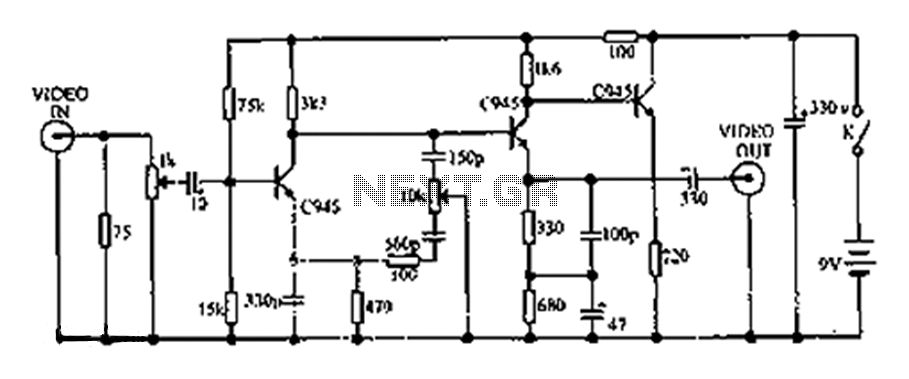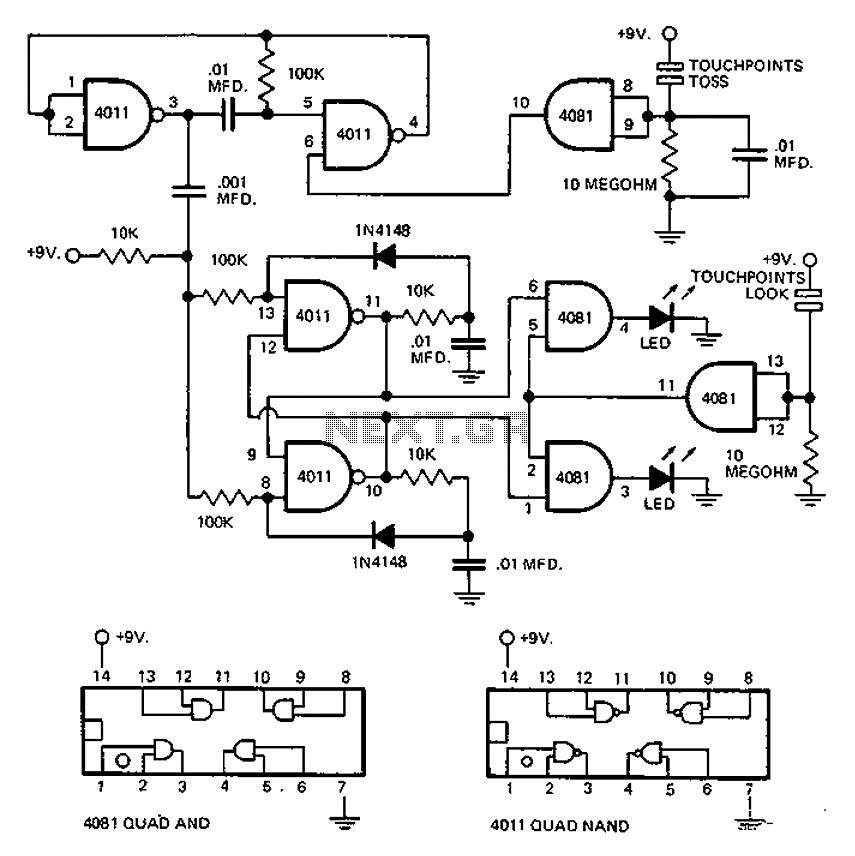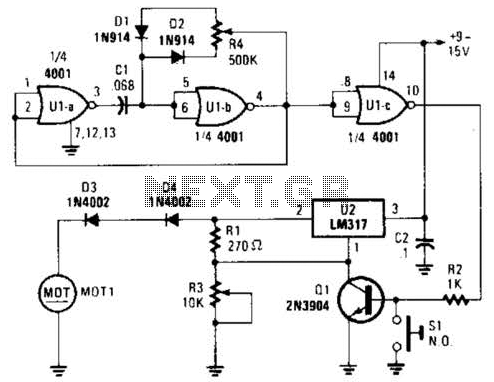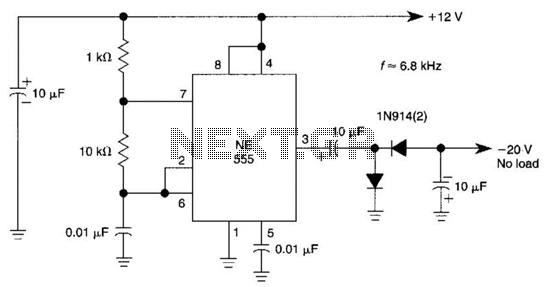
Digital Ber-password circuit

The Digital Combination Lock Circuit is a schematic for a simple electronic combination lock utilizing the LS7220 integrated circuit (IC). This password-protected digital lock can activate a relay to control any device by entering a preset combination of four digits. The circuit operates within a voltage range of 5V to 12V. To configure the combination, connect the designated switches to pins 3, 4, 5, and 6 of the IC via a header. For instance, if switch S1 is connected to pin 3, S2 to pin 4, S3 to pin 5, and S4 to pin 6, the combination would be 1234, allowing for the creation of any four-digit combinations. The remaining switches should be linked to pin 2 of the IC, which will reset the IC if an invalid key is pressed, necessitating the re-entry of the entire key code. Upon entering the correct combination, the output (relay) is activated for a predetermined duration set by capacitor C1, which is configured for 6 seconds in this example; increasing the capacitance of C1 will extend the activation time. The keypad should be arranged as a 3x4 matrix on a printed circuit board (PCB), and the digits can be marked on the keys. Alternatively, using symbols instead of numbers may add an additional layer of confusion for potential unauthorized users.
The Digital Combination Lock Circuit is designed to provide a secure method for controlling devices through a simple user interface. The LS7220 IC serves as the core component, managing the input from the keypad and processing the combination entries. The relay output allows for versatile applications, enabling the control of various electronic devices such as lights, motors, or alarms based on the user's input.
To implement the circuit, it is essential to ensure proper connections between the IC and the switches. The four switches designated for the combination must be connected to the specified pins, enabling the user to input their unique four-digit code. The additional switches connected to pin 2 act as a safeguard, resetting the system if an incorrect entry is detected, thus enhancing security by preventing unauthorized access.
The timing mechanism, determined by capacitor C1, plays a crucial role in the operation of the relay. The choice of capacitance will directly affect how long the relay remains activated after the correct combination is entered. This feature allows for customization based on the specific requirements of the application, whether for a brief activation or a longer duration.
The layout of the keypad is another critical aspect of the design. Arranging the switches in a 3x4 matrix not only optimizes space on the PCB but also provides a familiar interface for users. The decision to label the keys with symbols instead of numbers can serve as an effective deterrent against unauthorized attempts to gain access, adding an additional layer of complexity for potential intruders.
Overall, the Digital Combination Lock Circuit is an effective solution for implementing electronic access control. Its straightforward design, combined with the flexibility of the LS7220 IC, makes it suitable for a variety of applications requiring secure and reliable operation.Circuit Kunci Digital Ber-password is the circuit diagram of a simple electronic combination lock usingLS 7220. Circuit Kunci Digital Ber-password Password Digital can be used to activate a relay for controlling (on & off) any device when a preset combination of 4 digits are pressed.
The circuit can be operated from 5V to 12V. To set the combinatio n connect the appropriate switches to pin 3, 4, 5 and 6 of the IC through the header. As an example if S1 is connected to pin 3, S2 to pin 4, S3 to pin 5, S4 to pin 6 of the IC, the combination will be 1234. This way we can create any 4 digit combinations. Then connect the rest of the switches to pin 2 of IC. This will cause the IC to reset if any invalid key is pressed, and entire key code has to be re entered.
When the correct key combination is pressed the out put ( relay) will be activated for a preset time determined by the capacitor C1. Here it is set to be 6S. Increase C1 to increase on time. For the key pad, arrange switches in a 3X4 matrix on a PCB. Write the digits on the keys using a marker. Instead of using numbers I wrote some symbols!. The bad guys will be more confused by this. 🔗 External reference
The Digital Combination Lock Circuit is designed to provide a secure method for controlling devices through a simple user interface. The LS7220 IC serves as the core component, managing the input from the keypad and processing the combination entries. The relay output allows for versatile applications, enabling the control of various electronic devices such as lights, motors, or alarms based on the user's input.
To implement the circuit, it is essential to ensure proper connections between the IC and the switches. The four switches designated for the combination must be connected to the specified pins, enabling the user to input their unique four-digit code. The additional switches connected to pin 2 act as a safeguard, resetting the system if an incorrect entry is detected, thus enhancing security by preventing unauthorized access.
The timing mechanism, determined by capacitor C1, plays a crucial role in the operation of the relay. The choice of capacitance will directly affect how long the relay remains activated after the correct combination is entered. This feature allows for customization based on the specific requirements of the application, whether for a brief activation or a longer duration.
The layout of the keypad is another critical aspect of the design. Arranging the switches in a 3x4 matrix not only optimizes space on the PCB but also provides a familiar interface for users. The decision to label the keys with symbols instead of numbers can serve as an effective deterrent against unauthorized attempts to gain access, adding an additional layer of complexity for potential intruders.
Overall, the Digital Combination Lock Circuit is an effective solution for implementing electronic access control. Its straightforward design, combined with the flexibility of the LS7220 IC, makes it suitable for a variety of applications requiring secure and reliable operation.Circuit Kunci Digital Ber-password is the circuit diagram of a simple electronic combination lock usingLS 7220. Circuit Kunci Digital Ber-password Password Digital can be used to activate a relay for controlling (on & off) any device when a preset combination of 4 digits are pressed.
The circuit can be operated from 5V to 12V. To set the combinatio n connect the appropriate switches to pin 3, 4, 5 and 6 of the IC through the header. As an example if S1 is connected to pin 3, S2 to pin 4, S3 to pin 5, S4 to pin 6 of the IC, the combination will be 1234. This way we can create any 4 digit combinations. Then connect the rest of the switches to pin 2 of IC. This will cause the IC to reset if any invalid key is pressed, and entire key code has to be re entered.
When the correct key combination is pressed the out put ( relay) will be activated for a preset time determined by the capacitor C1. Here it is set to be 6S. Increase C1 to increase on time. For the key pad, arrange switches in a 3X4 matrix on a PCB. Write the digits on the keys using a marker. Instead of using numbers I wrote some symbols!. The bad guys will be more confused by this. 🔗 External reference





